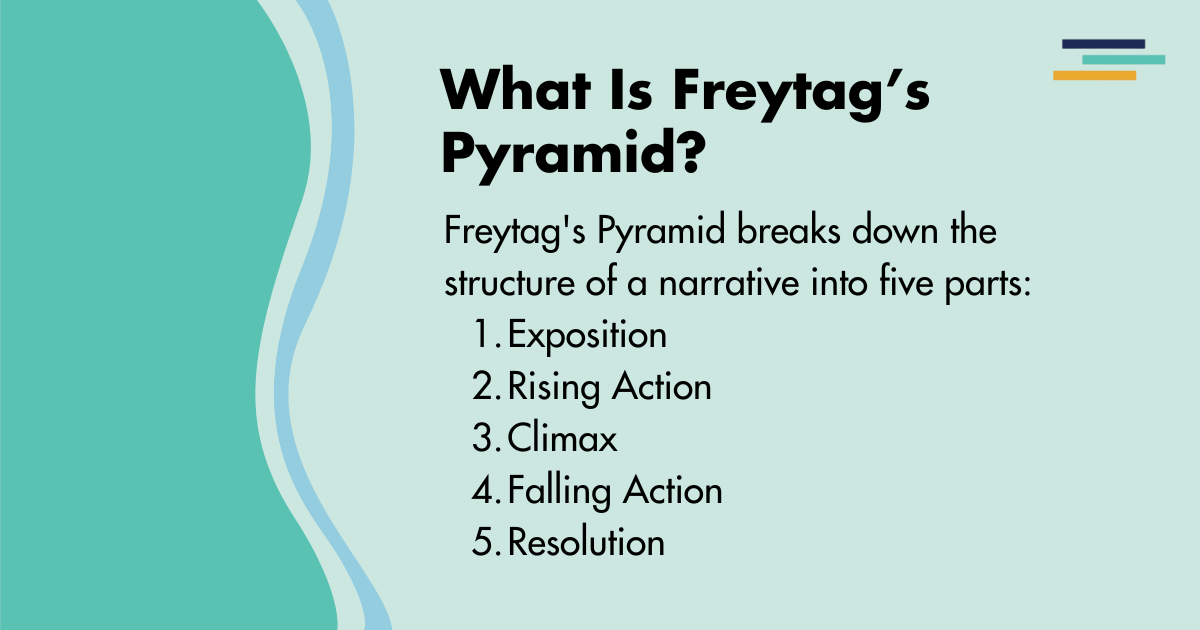
Ever felt like your story’s as flat as a pancake on a steamroller? Fear not, aspiring wordsmiths and veteran scribblers! There’s a time-honored tool that’s been helping writers craft captivating tales since steel nib pens were cutting-edge technology. Enter Freytag’s Pyramid—the narrative structure so reliable it could make even a grocery list read like a page-turner.
In this article, we’re going to scale the heights of Freytag’s Pyramid, explore its nooks and crannies, and maybe even plant a flag at its peak. Whether you’re penning the next Great American Novel or just trying to spice up your annual holiday letter, understanding this classic storytelling framework can transform your writing from “meh” to “more, please!”
So, grab your climbing gear (or just a comfy chair and your beverage of choice), and let’s embark on this literary expedition.
What Is Freytag’s Pyramid?
Before we start our ascent, let’s get acquainted with our mountain. Freytag’s Pyramid isn’t some ancient Egyptian wonder or a new-age meditation technique. It’s a storytelling structure that’s been shaping narratives since the 19th century.
Named after Gustav Freytag, a German novelist and playwright who probably wouldn’t have guessed he’d be famous for drawing triangles, this pyramid is essentially a fancy way of saying your story should have a beginning, middle, and end—but with more pizzazz and a couple of extra steps thrown in for good measure.
It starts with a simple triangle. But not just any triangle. This one is the backbone of every gripping tale you’ve ever encountered. From the heights of Mount Doom to the depths of the human psyche in Crime and Punishment, Freytag’s Pyramid has been the invisible architecture holding up stories that have captivated generations.
But why a pyramid, you ask? Well, besides making writers feel like literary pharaohs, this shape visually represents the rise and fall of tension in a well-crafted story. It’s like a mountain for your plot—complete with a thrilling ascent, a breathtaking peak, and a satisfying descent. And unlike real mountain climbing, there’s no risk of altitude sickness.
At its core, Freytag’s Pyramid breaks down the dramatic structure of a narrative into five essential parts:
- Exposition (aka “Setting the Stage”)
- Rising Action (or “Things Get Interesting”)
- Climax (the “Oh Snap!” moment)
- Falling Action (the “What Just Happened?” phase)
- Resolution (where everything ties up neatly… or does it?)
Each of these stages plays a crucial role in creating a satisfying story arc. Think of them as essential waypoints on your narrative expedition—skip one, and you might find yourself lost in a plot wilderness with no trail markers in sight.
But don’t worry if this all sounds a bit daunting. By the time we’re done here, you’ll be navigating story structures with the skill of a seasoned mountaineer. We’ll equip you with the literary equivalent of a top-notch GPS and a well-stocked backpack of writing techniques.
And who knows? Maybe you’ll even start seeing Freytag’s Pyramid everywhere—in your favorite TV shows, movies, and even in that suspiciously dramatic retelling of your neighbor’s run-in with a squirrel.

What Are the 5 Stages of Plot?
Our first step in this story-scaling expedition is to break down the individual stages of our narrative mountain. Each of these five stages represents a crucial part of your storytelling journey, from the gentle foothills of the introduction to the dizzying peak of the climax and back down to the satisfying conclusion valley.
As we explore each stage, remember that like any good climbing expedition, the key is balance. Spend too long at base camp (exposition), and your readers might lose interest before the real adventure begins. Rush to the summit (climax) without proper preparation, and the payoff might feel underwhelming. It’s all about pacing, build-up, and knowing when to plant your flag at the top.
Exposition: Base Camp Basics
Think of exposition as your story’s welcome center. Here, you’ll introduce your main characters (your climbing team), establish the setting (Is this a cozy cabin mystery set in the Rockies or an epic fantasy quest on Magic Mountain?), and hint at the conflicts to come (Is there a dragon at the peak? A long-lost treasure? Or just the satisfaction of conquering a personal Everest?).
The trick with exposition is to keep it lean and interesting. Nobody wants to sit through a three-hour safety briefing before starting their adventure. Give your readers just enough information to pique their interest and get them oriented. Drop in intriguing details like trail markers, leading them deeper into your story’s wilderness.
Remember, the goal here isn’t to unpack every piece of gear in your narrative backpack. It’s to get your readers excited about the journey ahead. So, keep it snappy, sprinkle in some intrigue, and before you know it, your audience will be raring to start the real climb.
Pro tip: Try weaving your exposition naturally into the early action. Instead of a long-winded description of your protagonist’s backstory, show us a photo of their long-lost love as they pack their climbing gear. It’s all about creating that “Ooh, what’s that about?” moment that’ll keep readers trudging along with you.
Rising Action: The Uphill Climb
Rising action is where your story starts to gain elevation, and the air gets a little thinner (in a good way, we promise).
This is the longest part of your journey, where you’ll encounter obstacles, meet interesting characters, and uncover clues. It’s a series of increasingly challenging switchbacks on your plot mountain. Each turn reveals new challenges for your characters and raises the stakes higher than the last ridge you climbed.
Your job here is to keep your readers huffing and puffing along with your characters, always wondering what’s around the next bend. Introduce conflicts, throw in some red herrings, and maybe add a few narrative crevasses to navigate. You want your readers too engrossed to realize how far they’ve come until they look back and can’t even see where they started.
Climax: Summit Fever
You’ve made it! The peak is in sight, and it’s time for that final push to the top. The climax is the highest point of your story mountain, where tensions reach their zenith and conflicts come to a head.
This is the moment readers have been anticipating since they laced up their boots at base camp. It’s the big showdown, the moment of truth, the…well, you get the idea. It’s big.
But remember, just like reaching a mountain’s summit, the climax may be intense and breathtaking, but it’s also relatively brief. Give your readers that moment of awe as they survey the narrative landscape from the top, then start planning your descent. After all, nobody wants to get stuck on a narrative mountain after dark.
Falling Action: The Descent Begins
Whew! You’ve conquered the peak, but your journey isn’t over yet. Falling action is where you begin your careful climb down from the story’s highest point. This is where you start tying up loose ends and showing the immediate consequences of the climax.
Think of this stage as the part of the hike where you’re still buzzing from the summit view, but your legs are starting to feel a bit wobbly. Your characters are dealing with the aftermath of the big climactic event, catching their breath, and maybe even enjoying a few moments of celebration or reflection.
But don’t lose momentum! Keep your readers engaged by hinting at how the adventure has changed your characters. Are they the same people who started this journey, or have they been transformed by their trials?
Resolution: Back to Base Camp
At last, you’ve made it back to base camp, but you’re not the same as when you left. The resolution is where you show how the journey has changed your characters and their world.
This is your chance to give readers that satisfying sense of closure. Tie up any remaining loose ends, reveal the final consequences of the climax, and show how your characters have grown or changed through their adventure.
But beware the overly tidy ending! Just like a real mountain expedition, there might be a few scrapes and bruises, some unresolved tensions, or hints of future adventures on the horizon. The best resolutions leave readers satisfied but also give them something to ponder as they close the book.
Remember, a good resolution doesn’t mean explaining every little detail. It’s about giving your readers a comfortable place to rest after their long narrative journey, while perhaps leaving a few scenic outlooks for them to gaze at and wonder, “What’s over there?”
Other Dramatic Structure Options
While Freytag’s Pyramid is a classic for a reason, it’s not the only path up the storytelling mountain. Let’s take a quick look at some alternative routes that might suit your narrative expedition.
The Hero’s Journey: The Scenic Route
Imagine Freytag’s Pyramid, but instead of a straightforward climb, you’re taking a round-the-world trek. Joseph Campbell’s Hero’s Journey is like the gap year of story structures—it’s longer, more complex, and you might come back with a few souvenirs (or magical artifacts) you didn’t expect.
This 12-stage adventure is perfect for epic tales where characters undergo profound transformations. It’s less about scaling a single peak and more about conquering an entire mountain range of personal growth and external challenges.
Kishōtenketsu: The Zen Garden Path
This storytelling structure is less about conquering mountains and more about finding harmony. Kishōtenketsu, popular in East Asian narratives, focuses on exploration and revelation rather than conflict and resolution.
This four-act structure is like taking a meditative walk through a narrative landscape, where the “twist” comes from a shift in perspective rather than a climactic battle. It’s perfect for stories that are more about internal journeys or subtle societal observations.
The 3-Act Structure: The Classic Road Trip
If Freytag’s Pyramid is a mountain climb, the 3-act structure is more like a cross-country road trip. It’s a time-honored storytelling vehicle that’s been cruising down the highways of narrative for decades, particularly popular in screenwriting and modern novels.
This structure breaks down your story into three distinct acts, punctuated by five key plot points:
- Inciting Incident: This is the event that sets your protagonist’s journey in motion.
- Plot Point 1: This marks the end of Act 1. It’s often a moment of no return for your character, propelling them fully into the main conflict.
- Midpoint: Smack in the middle of Act 2, this is where things often take a significant turn. It might be a false victory, a major setback, or a radical shift in perspective.
- Plot Point 2: This kicks off Act 3 and is typically the lowest point for your protagonist. It’s the moment that pushes them towards the final confrontation.
- Climax: The big showdown, the moment of truth, the final exam—whatever you want to call it, this is where your story reaches its peak tension and your protagonist faces their ultimate challenge.
Remember, these structures are tools, not rules. Feel free to blaze your own trail or combine elements from different paths. After all, the best stories often come from explorers who aren’t afraid to venture off the beaten path now and then.
Examples of the Plot Pyramid in Literature
Now let’s take a quick tour of some famous literary landscapes, in order to see Freytag’s Pyramid in action.
To Kill a Mockingbird: Small Town, Big Drama
Harper Lee’s classic starts off feeling like a lazy summer stroll through childhood memories but slowly climbs to a courtroom summit that’ll leave you gasping.
- Exposition: Welcome to sleepy Maycomb, Alabama. Meet Scout, Jem, and their mysterious neighbor, Boo Radley.
- Rising Action: The town gets shaken up as Atticus defends Tom Robinson, tensions rise, and the kids start to see their world differently.
- Climax: The trial reaches its peak, and justice takes an unexpected tumble.
- Falling Action: The aftermath of the trial ripples through the town.
- Resolution: A Halloween night attack brings everything full circle, with Boo Radley finally stepping into the light.
Romeo and Juliet: Star-Crossed Lovers and a Perfectly Pointed Pyramid
Shakespeare’s tragedy is the Everest of dramatic structures—a perfect, steep climb to a catastrophic peak.
- Exposition: Two households, both alike in dignity, in fair Verona where we lay our scene.
- Rising Action: Secret meetings, hasty marriages, and escalating family feuds. The tension rises faster than Romeo’s heart rate at the Capulet ball.
- Climax: A fatal misunderstanding leads to a double suicide that would put any modern soap opera to shame.
- Falling Action: The families discover the tragic lovers and realize the cost of their feud.
- Resolution: The Montagues and Capulets finally bury the hatchet, but at a devastating price.
The Hunger Games: Arrows, Action, and Narrative Arcs
Suzanne Collins gives us a modern take on the pyramid, creating a macro-level Freytag’s Pyramid that encompasses the entire trilogy:
- Exposition (Book 1): We’re introduced to Panem, the oppressive Capitol, and our reluctant hero Katniss Everdeen.
- Rising Action (Books 1-2): Katniss’s defiance in the first Games sparks unrest. Tensions escalate in “Catching Fire” with the Quarter Quell and growing rebellion.
- Climax (Book 3): The full-scale rebellion against the Capitol reaches its peak in “Mockingjay,” with Katniss becoming the face of the revolution.
- Falling Action (Late Book 3): The aftermath of the war, Katniss’s assassination of President Coin, and the establishment of a new government.
- Resolution (End of Book 3): Katniss retreats to District 12, dealing with trauma and finding a quiet life with Peeta.
Each of these examples shows how Freytag’s Pyramid can be adapted to different genres, time periods, and narrative styles. Whether you’re crafting a thought-provoking drama, a timeless tragedy, or a dystopian thriller, this trusty structure can help you map out a story that will keep readers scrambling to the summit alongside your characters.

Tips For Using Freytag’s Triangle
You’ve got the map, you’ve seen the examples, and now it’s time to pack your bags for your own narrative expedition. Here are some trail-tested tips to help you make the most of Freytag’s Pyramid:
- Flex that structure: Remember, Freytag’s Pyramid is a guide, not a straitjacket. Feel free to stretch or compress sections to fit your story’s unique terrain.
- Subplots are like side quests: Weave them into your main path, but make sure they don’t lead your readers off a cliff.
- Pacing is key: Like any good hike, vary your story’s pace. Mix steep climbs (high tension) with moments to catch your breath (reflection or humor).
- Plant foreshadowing flags: Drop hints early on about what’s to come. It’s like leaving trail markers that’ll make sense when your readers look back.
- The view from the top: Make sure your climax is worth the climb. It should be the narrative equivalent of a breathtaking summit vista.
- Don’t rush the descent: The falling action and resolution are your cooldown. Give readers time to process the journey.
- Character growth is the real summit: Your characters should be changed by the climb. Make their internal journey as compelling as the external one.
- Draft in elevation: It’s okay if your first draft is more of a gentle hill than a majestic mountain. Revision is where you carve out those dramatic slopes.
- Genre matters: A romance novel might have a different-shaped pyramid than a mystery. Adjust accordingly.
- Sometimes, break the rules: Once you know the structure, you’ll know how to subvert it effectively. Sometimes the most memorable journeys are the unexpected ones.
Remember, every great story is an adventure, and you’re the guide. Use Freytag’s Pyramid to chart a course, but don’t be afraid to explore uncharted territory along the way.
Reaching Your Story’s Summit
Well, intrepid plot explorers, we’ve scaled the heights of Freytag’s Pyramid, navigated through literary landscapes, and picked up some valuable storytelling gear along the way. By now, you should be ready to lead your own narrative expeditions with confidence.
Whether you’re crafting a short story sprint or an epic novel trek, remember that Freytag’s Pyramid is your trusty compass. It’ll help you keep your bearings, but the specific path you take is entirely up to you. Maybe you’ll follow the traditional route, or perhaps you’ll forge a new trail that future writers will study in awe.
And here’s some good news for those of you who like a little extra help on your writing journey: tools like Fictionary are available to assist you in mapping out your story’s structure. Think of it as a high-tech GPS for your narrative expedition, helping you navigate the twists and turns of your plot while keeping Freytag’s principles in mind.
As you set out to conquer your own story mountains, keep in mind that every great tale, like every great adventure, starts with a single step. So lace up those writing boots, pack your imagination, and start climbing. Your readers are waiting for the journey of a lifetime.
And who knows? With Freytag as your guide and tools like Fictionary at your disposal, you might just write the next literary masterpiece that has future scribblers analyzing its narrative topography. Now get out there and make some storytelling history!


